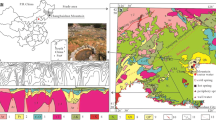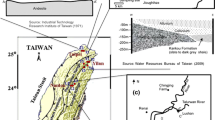Abstract
Across mainland China, Tengchong is geothermally unique because both magmatic-hydrothermal systems and late Cenozoic volcanic activities have been observed there. Rehai, located in the Tengchong volcanic area, is the only hydrothermal system in mainland China discharging acid springs with very low pH values. Two types of acid geothermal waters were identified: one is sulfate waters with low chloride concentrations and pH levels as low as around 2; the other has slightly higher chloride concentrations and is marked with diversified hydrochemical types. Both types of acid springs at Rehai are immature waters and far from being equilibrated with a thermodynamically stable mineral assemblage comprising albite, K–feldspar, muscovite, and clinochlore characteristic for felsic rock-hosted reservoirs. In contrast to those neutral chloride springs at Rehai that are formed via boiling, conductive cooling or mixing with cold groundwaters of a parent geothermal liquid (PGL), the sulfate-rich acid waters discharged from the Diretiyan area, the Dagunguo area, and the Shizitou Spring of Rehai are essentially locally perched groundwaters heated by H2S-rich steam separated from deep geothermal fluid. The acidity of these waters originates from the oxidation of H2S in near-surface environment. In contrast, the acid waters with higher chloride concentrations are the results of mixing between steam-heated waters and neutral chloride waters. The geochemical geneses of the Rehai geothermal springs inferred based on stable hydrogen and oxygen isotopes are generally identical. Unlike active volcanic areas across the world, there is a lack of acid waters at Rehai formed through partial neutralization of magmatic fluid, possibly owing to the comparatively deep-seated magma chamber there (no less than 7 km deep).







Similar content being viewed by others
References
Armienta MA, Cruz-Reyna SD, Macías JL (2000) Chemical characteristics of the crater lakes of Popocatetetl, El Chichon, and Nevado de Toluca volcanoes, Mexico. J Volcanol Geoth Res 97(1–4):105–125
Bai DH, Liao ZJ, Zhao GZ, Wang XB (1994) The inference of magmatic heat-source beneath the Rehai (hot sea) field of Tengchong from the result of magnetotelluric sounding. Chinese Sci Bull 39(7):572–577
Bai DH, Meju MA, Liao ZJ (2001) Magnetotelluric images of deep crustal structure of the Rehai geothermal field near Tengchong, southern China. Geophys J Int 147(3):677–687
Ball JW, McCleskey RB, Nordstrom DK (2010) Water chemistry data for selected springs, geysers, and streams in Yellowstone National Park, Wyoming, 2006-2008. US Geol. Surv. Open-File Report 2010-1192. <http://pubs.usgs.gov/of/2010/1192/>Bienkowski
Bienkowski R, Torres-Alvarado IS, Hinderer M (2005) Geochemical modeling of acid fluids in Los Humeros geothermal field, Mexico. Proceedings World Geothermal Congress 2005. Antalya, Turkey, 24-29 April 2005
Bixley PF, Clotworthy AW, Mannington WI (2009) Evolution of the Wairakei geothermal reservoir during 50 years of production. Geothermics 38(1):145–154
Brock TD (1971) Bimodal distribution of pH values of thermal springs of the world. Geol Soc Am Bull 82(5):1393–1394
Coleman ML, Shepard TJ, Durham JJ, Rouse JE, Moore GR (1982) Reduction of water with zinc for hydrogen analysis. Anal Chem 54(1):993–995
Coplen TB (1993) Normalization of oxygen and hydrogen isotope data. Chem Geol 72(4):293–297
Craig H (1963) The isotopic geochemistry of water and carbon in geothermal areas. In (Ed) Tongiorgi, E. Nuclear Geology of Geothermal Areas, Spoleto, Italy, 17-53
Deng YM, Nordstrom DK, McCleskey RB (2011) Fluoride geochemistry of thermal waters in Yellowstone National Park: I. Aqueous fluoride speciation. Geochim Cosmochim Acta 75(16):4476–4489
Ellis AJ, Mahon WAJ (1964) Natural hydrothermal systems and experimental hot water/rock interactions. Geochim Cosmochim Acta 28(8):1323–1357
Ellis AJ, Mahon WAJ (1967) Natural hydrothermal systems and experimental hot water/rock interactions (Part II). Geochim Cosmochim Acta 31(4):519–538
Giggenbach WF (1978) The isotopic composition of waters from the El Tatio geothermal field, northern Chile. Geochim Cosmochim Acta 42(7):979–988
Giggenbach WF (1988) Geothermal solute equilibria—derivation of Na-K-Mg-Ca geoindicators. Geochim Cosmochim Acta 52(12):2749–2765
Giggenbach WF, Soto RC (1992) Isotopic and chemical-composition of water and steam discharges from volcanic magmatic hydrothermal systems of the Guanacaste Geothermal Province, Costa-Rica. Appl Geochem 7(4):309–332
Giggenbach WF, Stewart MK (1982) Processes controlling the isotopic composition of steam and water discharges from steam vents and steam-heated pools in geothermal areas. Geothermics 11(2):71–80
Giggenbach WF, Garcia NP, Londoño AC, Rodriguez LV, Rojas NG, Calvache MLV (1990) The chemistry of fumarolic vapor and thermal-spring discharges from the Nevado del Ruiz volcanic-magmatic-hydrothermal system, Colombia. J Volcanol Geotherm Res 42(1–2):13–39
Giggenbach WF, Sheppard DS, Robinson BW, Stewart MK, Lyon GL (1994) Geochemical structure and position of the Waiotapu geothermal field, New Zealand. Geothermics 23(5–6):599–644
Guo Q (2012) Hydrogeochemistry of high-temperature geothermal systems in China: a review. Appl Geochem 27(10):1887–1898
Guo Q, Wang Y (2012) Geochemistry of hot springs in the Tengchong hydrothermal areas, southwestern China. J Volcanol Geotherm Res 215:61–73
Guo Q, Wang Y, Liu W (2007) Major hydrogeochernical processes in the two reservoirs of the Yangbajing geothermal field, Tibet, China. J Volcanol Geotherm Res 166(3–4):255–268
Guo Q, Wang Y, Liu W (2009) Hydrogeochemistry and environmental impact of geothermal waters from Yangyi of Tibet, China. J Volcanol Geotherm Res 180(1):9–20
Hedenquist JW, Aoki M (1991) Meteoric interaction with magmatic discharges in Japan and the significance for mineralization. Geology 19(10):1041–1044
Liao Z, Zhao P (1999) Yunnan-Tibet geothermal belt—geothermal resources and case Histories. Science Press, Beijing (in Chinese with English abstract)
Liao Z, Yin Z, Jia X, Lu W (1997) Conceptual model of the Rehai (hot sea) geothermal field in Tengchong, Yunnan Province, China. Geol J China Univ 3(2):212–221
Marini L, Fung AY, Sanchez E (2003a) Use of reaction path modeling to identify the processes governing the generation of neutral Na-Cl and acidic Na-Cl-SO4 deep geothermal liquids at Miravalles geothermal system, Costa Rica. J Volcanol Geotherm Res 128(4):363–387
Marini L, Zuccolini MV, Saldi G (2003b) The bimodal pH distribution of volcanic lake waters. J Volcanol Geotherm Res 121(1–2):83–98
McCleskey RB, Campbell KM, Nordstrom DK, Ball JW (2014) Water-chemistry data for selected hot springs, geysers and streams in Yellowstone National Park, Wyoming, 2009-2013. US Geol. Surv. Open-File Report (in review)
Nordstrom DK, McCleskey RB, Ball JW (2009) Sulfur geochemistry of hydrothermal waters in Yellowstone National Park: IV Acid–sulfate waters. Appl Geochem 24(2):191–207
Parkhurst DL, Appelo CAJ (1999) A computer program for speciation, batch-reaction, one-dimensional transport, and inverse geochemical calculations. U.S. Geological Survey, Denver, p 312
Shangguan Z (2000) Structure of geothermal reservoirs and the temperature of mantle-derived magma hot source in the Rehai area. Acta Petrol Sin 16(1):83–90
Shangguan ZG, Bai CH, Sun ML (2000) Mantle-derived magmatic gas releasing features at the Rehai area, Tengchong County, Yunnan Province, China. Sci China Ser D 43(2):132–140
Tong W, Zhang M (1989) Geothermics in Tengchong. Science Press, Beijing, p 262
Tong W, Zhang M (1994) Thermal springs in Traverse Mountains region. Science Press, Beijing, p 326
Tong W, Mu Z, Liu S (1990) The late Cenozoic volcanoes and active high-temperature hydrothermal systems in China. Acta Geophys Sin 33(3):329–335
Tong W, Liao Z, Liu S, Zhang Z, You M, Zhang M (2000) Thermal springs in Tibet. Science Press, Beijing, p 300
Zhang Z, Liu S, Zhao F (1987) Geochemistry of thermal waters in the Tengchong volcanic geothermal area, west Yunnan Province, China. Geothermics 16(2):169–179
Zhang G, Liu C, Liu H, Jin Z, Han G, Li L (2008) Geochemistry of the Rehai and Ruidian geothermal waters, Yunnan Province, China. Geothermics 37(1):73–83
Zhao P, Liao ZJ, Guo GY, Zhao FS (1996) Steam quantitative analysis and its implication in the Rehai geothermal field, Tengchong. Chin Sci Bull 41(6):501–505
Acknowledgments
This study was financially supported by the National Natural Science Foundation of China (No. 41120124003), the Ministry of Education of China (111 project, No. B08030), the Research fund of Bureau of Science and Technology of Qinghai Province (No. 2013-G-Q08A), and the Fundamental Research Fund for National Universities, China University of Geosciences (Wuhan) (Nos. CUG120505 and CUG120113). The very helpful comments of two reviewers and Associate Editor Clive Oppenheimer are gratefully acknowledged.
Author information
Authors and Affiliations
Corresponding author
Additional information
Editorial responsibility: C. Oppenheimer
Electronic supplementary material
Below is the link to the electronic supplementary material.
ESM 1
(DOC 445 kb)
Rights and permissions
About this article
Cite this article
Guo, Q., Liu, M., Li, J. et al. Acid hot springs discharged from the Rehai hydrothermal system of the Tengchong volcanic area (China): formed via magmatic fluid absorption or geothermal steam heating?. Bull Volcanol 76, 868 (2014). https://doi.org/10.1007/s00445-014-0868-9
Received:
Accepted:
Published:
DOI: https://doi.org/10.1007/s00445-014-0868-9




